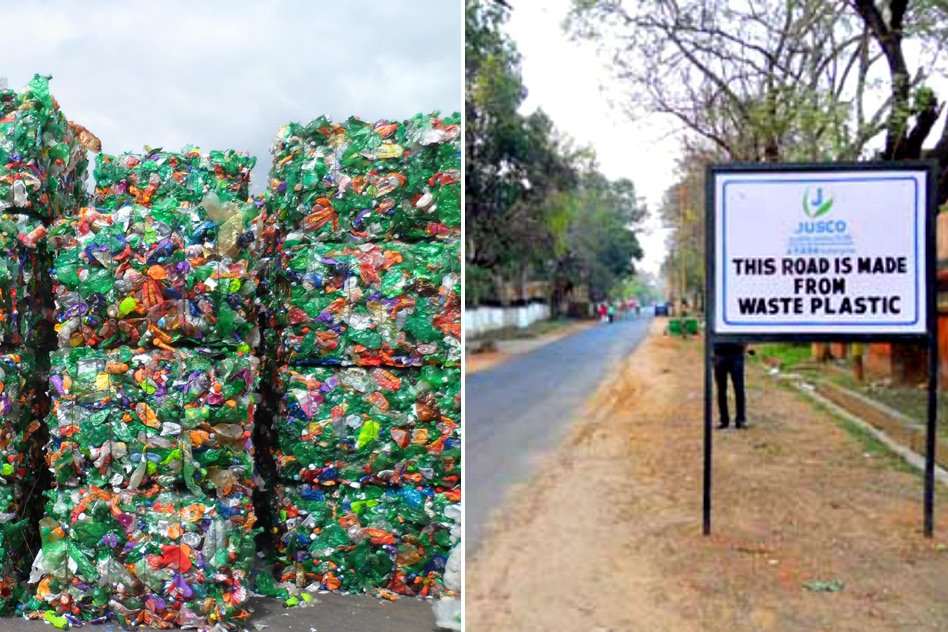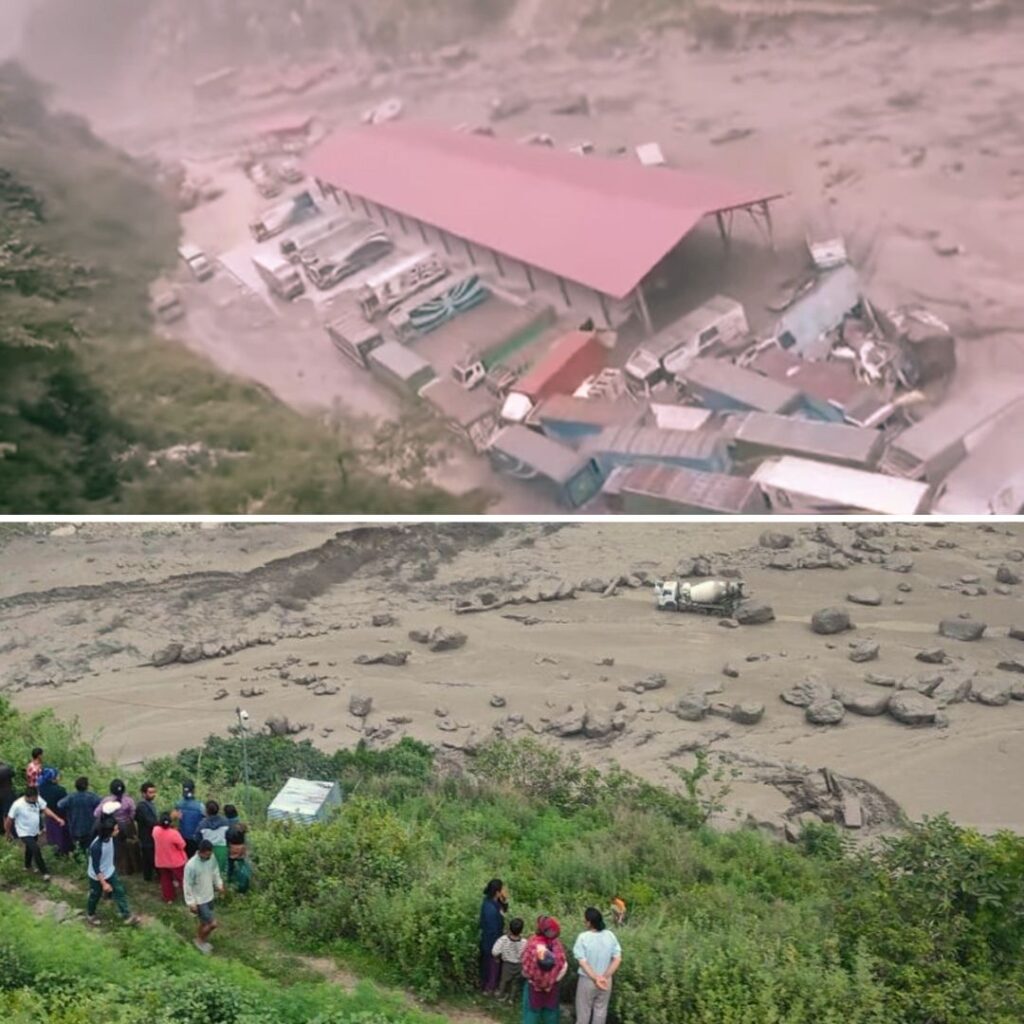Image Source: builtconstructions, shabra
Recently, a post in The Logical Indian celebrated the use of waste plastic for road laying as a possible solution to the mounting crisis of plastics contamination.
This is an effort to explain why I think this intervention is not a solution.
First, something about the details of the “success story.” Innovated by Dr. A. Vasudevan, a chemist from Thiagarajar College of Engineering (TCE), Madurai, the plastic-bitumen road-laying technique is a patented idea. Dr. Vasudevan does not intend to profit from it. Rather, he is making it available to municipalities to tackle the mounting waste plastic piles. The intent is good.
The technology is simple and is described in a dedicated TCE website.
It involves
a) collecting waste plastics, including plastic carry bags, cups, soft and hard foams and laminated plastics;
b) cleaning it by washing;
c) shredding it to a uniform size;
d) melting the waste plastics at 165 degree celsius at temperatures of 166 degree celsius, and blending it with hot aggregates and bitumen and using this mixture to lay the road.
To understand the efficacy of a solution, it is important to understand what is seen as the problem.
According to the Worldwatch Insitute, “From 1950 to 2012, plastics growth averaged 8.7 percent per year, booming from 1.7 million tons to the nearly 300 million tons of today.” [Source: Worldwatch Institute. “Vital Signs, Volume 22: Trends that are shaping our future.” 2015.] The recent rains in Chennai left us with haunting images of plastic trashed beaches.
Every year, about 8 million tonnes of plastic waste is dumped into our oceans. Floating bags of plastic are mistaken for jelly fish and consumed by whales and turtles. Brightly coloured plastic items attract sea birds and mammals that ingest them and die. Midway Atoll is 2000 miles from the nearest human settlement in the Pacific. But its beaches are littered with plastic trash. See this video to understand my cynicism with people who say recycling is the answer to plastic pollution.
Plastics dumped on land too break down into tiny pieces and are washed down water courses into rivers, lakes and seas. These microplastics are hugely problematic. http://www.greenfacts.org/…/marine…/l-2/3-micro-plastics.htm They absorb other pollutants like legacy pesticides and carcinogenic hydrocarbons from the ocean or aquatic environment. These microscopic toxic bombs tend to be mistaken for food and ingested by zooplankton. Planktons are the foundations of any aquatic food chain, and plastics has found a way to contaminate that.
Despite all the talk about “Reduce, Reuse and Recycle” — a mantra that ironically was promoted by the plastics manufacturers themselves – plastics production continues to grow at a steady rate of 9 percent.
Plastics are virtually indestructible, and any attempts to destroy them give rise to new problems and new pollutants.
So what’s my problem with plastic roads?
a) End-of-pipe interventions contribute to the perpetuation of the problem – By making it seem as if there is a safe, sustainable and efficient way of disposing plastics, interventions such as this tend to take the focus off the steadily mounting plastics crisis — increasing plastic production, the inherent unsustainability of the industry and the toxic pollution associated with production, use and disposal of plastics. The sooner we admit that we need to phase out plastics, the sooner we will begin the earnest quest for alternatives.
b) Far from being a solution to plastic pollution, plastic road-making itself is a source of pollution. Dr. Vasudevan specifies that only polypropylene (PP), polystyrene (PS) and polyethylene (PE) polymers should be used, and that PVC (polyvinyl chloride or flex) should not be allowed to contaminate the feedstock of waste plastics used in road laying. Thermal degradation of PVC, he says, will result in the emissions of harmful gases like hydrochloride acid. Dr. Vasudevan is right about PVC. But this caveat conveys the wrong impression that heating PP, PS or PE plastics will be safe. These plastics too release toxic gases when heated.
Plastics are not merely molecules of carbon and hydrogen. To convert them into daily-use products, chemical additives are added to give them flexibility (softeners and plasticisers), to delay degradation due to heat or sunlight (stabilisers and anti-oxidants), to give them colour, to make them fire proof (flame retardants), to give them body (fillers). The toxicity of most of these chemicals is not known. But the few chemicals that have been studied – like phthalates – a category of chemicals used as softeners, or brominated flame retardants are highly toxic. They can cause birth defects and cancer, and hormonal problems particularly for women. Because they persist in the environment and can build up in the food chain, even seemingly insignificant amounts in the environment can grow to deadly levels in our bodies or in the food we eat.
Studies reveal that even heating plastics such as PP, PE and PS releases moderate to highly toxic emissions – carbon monoxide, acrolein, formic acid, acetone, formaldehyde, acetaldehyde, toluene and ethylbenzene.http://www.sciencedirect.com/…/article/pii/S0045653508013532
Workers engaged in road-laying are particularly at risk from these emissions.
c) Questionable in theory; disastrous in practice – Theoretically, it should be possible to keep the super-toxic PVC from contaminating the plastic feedstock for road-laying. But I don’t see how that is going to happen. PVC is virtually indistinguishable from other plastics. The volume of plastics required for road laying makes it virtually impossible to ensure that PVC is kept out.
d) Impractical – According to a presentation on TCE’s website, a 107 square foot plastic road will require 1 lakh plastic carry bags. This makes it appear as though plastic roads are this inexhaustible sink for all the bags we use and throw. But plastic bags are not a collector’s item. No ragpicker will pick up carry bags. Because they are so light, a ragpicker would have to collect a hell of a lot of bags to get Rs. 3 per kg of scrap. So don’t hold your breath – the road to a landscape without carry bags is not a plastic road.
e) Microplastics – Putting the plastics in roads does not make plastics disappear. They are merely hiding. Over time, as the road weathers, the plastic too breaks down into micro particles of plastic and enter the environment. Scientific studies have found more microplastics than plankton in oceans. Algalita Foundation, which studies plastics in marine environment, reported plastics to plankton ratios of 5.44:1 to 128:1 measured by dry weight.
f) Unsustainable – As my garbage guru Paul Connett reminds us, attempting to destroy plastics as a solution to the plastic problem behooves a deeper question. Why are we destroying resources that we should be sharing with the future generations? Plastics are made out of petroleum – a finite non-renewable resource. We have already brought ourselves to the brink of climate catastrophe with all the burning we have done over the last two centuries.
“So what’s the alternative?” you may ask. Alternative to what? If you are looking for an alternative way to safely, inexpensively, sustainably dispose plastic, you will not find any that fit the bill. If we are agreed on that, then we should collectively exercise our considerable human ingenuity to communicate the problem, highlight the urgency, and begin the phasing out of plastics by phasing in alternative material and lifestyles. Alternative material are already readily available for some of the plastic applications – cloth bags instead of carry bags, cardboard instead of thermocol/styrofoam packaging etc.
Some of the alternatives may not be as convenient as plastic is. But neither is it convenient to live in a dead planet.











